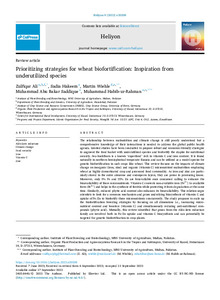| dc.date.accessioned | 2023-10-17T14:05:46Z | |
| dc.date.available | 2023-10-17T14:05:46Z | |
| dc.date.issued | 2023-10-05 | |
| dc.identifier | doi:10.17170/kobra-202310178864 | |
| dc.identifier.uri | http://hdl.handle.net/123456789/15111 | |
| dc.description.sponsorship | Gefördert durch den Publikationsfonds der Universität Kassel | |
| dc.language.iso | eng | |
| dc.rights | Attribution-NonCommercial-NoDerivatives 4.0 International | * |
| dc.rights.uri | http://creativecommons.org/licenses/by-nc-nd/4.0/ | * |
| dc.subject | Aldo-keto reductase | eng |
| dc.subject | Climate change | eng |
| dc.subject | Food security | eng |
| dc.subject | Iron | eng |
| dc.subject | Vitamin C | eng |
| dc.subject | Zinc | eng |
| dc.subject.ddc | 570 | |
| dc.subject.ddc | 630 | |
| dc.title | Prioritizing strategies for wheat biofortification: Inspiration from underutilized species | eng |
| dc.type | Aufsatz | |
| dcterms.abstract | The relationship between malnutrition and climate change is still poorly understood but a comprehensive knowledge of their interactions is needed to address the global public health agenda. Limited studies have been conducted to propose robust and economic-friendly strategies to augment the food basket with underutilized species and biofortify the staples for nutritional security. Sea-buckthorn is a known “superfood” rich in vitamin C and iron content. It is found naturally in northern hemispherical temperate Eurasia and can be utilized as a model species for genetic biofortification in cash crops like wheat. This review focuses on the impacts of climate change on inorganic (iron, zinc) and organic (vitamin C) micronutrient malnutrition employing wheat as highly domesticated crop and processed food commodity. As iron and zinc are particularly stored in the outer aleurone and endosperm layers, they are prone to processing losses. Moreover, only 5% Fe and 25% Zn are bioavailable once consumed calling to enhance the bioavailability of these micronutrients. Vitamin C converts non-available iron (Fe³+) to available form (Fe²+) and helps in the synthesis of ferritin while protecting it from degradation at the same time. Similarly, reduced phytic acid content also enhances its bioavailability. This relation urges scientists to look for a common mechanism and genes underlying biosynthesis of vitamin C and uptake of Fe/Zn to biofortify these micronutrients concurrently. The study proposes to scale up the biofortification breeding strategies by focusing on all dimensions i.e., increasing micronutrient content and boosters (vitamin C) and simultaneously reducing anti-nutritional compounds (phytic acid). Mutually, this review identified that genes from the Aldo-keto reductase family are involved both in Fe/Zn uptake and vitamin C biosynthesis and can potentially be targeted for genetic biofortification in crop plants. | eng |
| dcterms.accessRights | open access | |
| dcterms.creator | Ali, Zulfiquar | |
| dcterms.creator | Hakeem, Sadia | |
| dcterms.creator | Wiehle, Martin | |
| dcterms.creator | Saddique, Muhammad Abu Bakar | |
| dcterms.creator | Habib-ur-Rahman, Muhammad | |
| dcterms.extent | 16 Seiten | |
| dc.relation.doi | doi:10.1016/j.heliyon.2023.e20208 | |
| dc.subject.swd | Aldo-Keto Reductasen | ger |
| dc.subject.swd | Klimaänderung | ger |
| dc.subject.swd | Ernährungssicherung | ger |
| dc.subject.swd | Vitamin C | ger |
| dc.subject.swd | Eisen | ger |
| dc.subject.swd | Zink | ger |
| dc.type.version | publishedVersion | |
| dcterms.source.identifier | eissn:2405-8440 | |
| dcterms.source.issue | Issue 10 | |
| dcterms.source.journal | Heliyon | eng |
| dcterms.source.volume | Volume 9 | |
| kup.iskup | false | |


